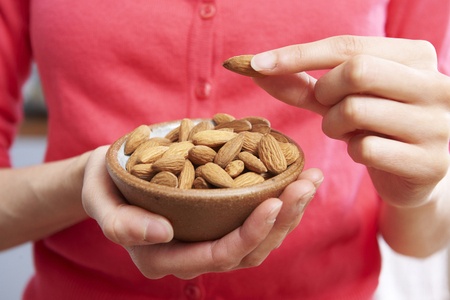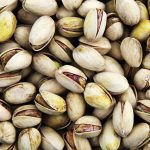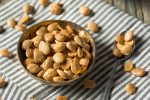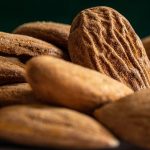
The almond is possibly the top choice for consumers because it is so nutritionally valuable, great visual appeal and is widely used in cooking especially for desserts.
The United States produces over 80% of the world’s almonds with Spain and Italy forming southern Europe as the next major contributor. California is the only state in the USA that produces them commercially and manufactures other products associated with milk and pastes. The Almond Board of California which is wholly devoted to promoting this nut has a fine website discussing all the merits of this product including an extremely comprehensive array of recipes.
Almond Types
In Europe especially Spain, there are specific almond types which are highly prized for Turron. The Mediterranean almond ‘Marcona’ is the standard. It is highly regarded for its taste and texture and ease in use in foods. It is a classic confectioner’s almond ad is widely used in cakes, baked foods but not generally nut butters. It has a good nutritional value and a high fat content. Many snack foods contain blanched and roasted kernels and this particular variety is also valued in this application.
The common almonds or ‘communas’ come from a number of cultivars which may or may not have names. They usually have a sweet flavour and will be used for pastes including turron, marzipan and other foods like ice cream and butters.
The ‘Desmayo Largueta’ originally developed from the common almond in Spain and is known specifically for its long shape. It also has a sweet and distinctive aroma and flavour which marks it out as a whole, unprocessed nut. It is often found sugared or used in savoury nut mixes. It appears to be easy to process – the shell can be removed relatively simply and separated.
Italy was a major centre of almond cultivation and had a well-known variety called Italian Seedling.
In the USA, there are a number of varieties known collectively as Californian almonds. These include ‘Carmel’, ‘Nonpareil’, ‘Sonora’, ‘Butte’, Moneterey and others which are falling out of use. They are used in pastry, confectionary and chocolate. They are grown because of their uniformity and general amenability to processing. They are also suited to the horticultural conditions of the West Coast and to the Sacramento Valley in particular
Appearance Of Almonds
Almonds have a tough grey-green outer hull covering a hard shell. The oval shaped kernel is covered by a thin brown skin.
Almond Harvesting
The almonds are harvested in the autumn (fall) by vigorous mechanical shaking of the tree. The nuts are collected in larges bags. Twigs, leaves, and other debris are removed carefully.
Reception
Following harvesting,the nuts are sent to various processing centres where they are then collectively passed onto cracking plants. At this stage, quality considerations come into play depending on the final outcome for processing the almonds and the type of specification required.
A typical evaluation will include moisture content, percentage of shelling required, the cultivar, remnants of debris, degree of spoilage and rotteness. If the almonds are to be used for nut butters, some samples will be converted at the lab-scale into a butter. Depending on the degree of specification, a poor quality consignment may well be discarded and composted.
A typical issue in processing is the moisture content of the nut. In some cases, if the harvested almonds are too wet, they are dried. The nuts are traditionally laid out on trays in thin layers under the sun or in silos where dry air at over 35 cent. is blown through the batch for many hours until excess moisture is removed.
In Spain, almonds required for confectionary such as turron are taken directly from the harvester to the cracking plants where they are then dried. In California, drying is still solar at the point of harvest and then these are collected and transported to whatever distribution centre requires them.
To maintain integrity before processing, all almonds are stored in dry and well-aerated containers to prevent mold contamination and growth. Most drying centres are within convenient distance of the processing plants
The Process Of Cracking Almonds
Almonds need to be a certain moisture before they are cracked open (seems ironic given the extent of drying required beforehand). The intention is to improve kernel elasticity and prevent breakage before the whole almond enters the processing plant.
Cracking takes the following steps in a cracking machine. A series of shear rollers mechanically removes the hull which is the outer covering with the nut still contained within its protective shell. The machine itself is designed so that the whole almond (hull + kernel) is forced through a series of circular bars. Whilst one bar is fixed, the other moves in a way that breaks the hull releasing the kernel.
In some machines these are literally holes and shell and kernel pass through together. Many of these nut crackers use groups of bars of different diameters which require calibration depending on the average size of the nut harvest passing through them.
The hull and any foreign material are then removed with vibratory screens and forced air separation.
The final separation involves removing as much of the shell pieces as possible. The kernels are sized by passing them through a series of perforated screens with holes of increasing size. Nowadays, the kernels are electronically sorted using advanced techniques like machine vision although some manual separation is still employed to remove many of the defective kernels and to remove as much debris as possible.
All nuts are graded accordingly. It may be the case that a second kernel selection process is needed to remove various pieces of foreign matter like stones, glass and hulls. Any rotten kernels are removed – these are usually dark and mishapen. Likewise, any mishapes and broken kernels can be removed. A final manual inspection is always needed before the kernels are passed onto the next phase of processing.
Kernel Drying
Given that the kernels have been moistened during the separation process means they need to be dried before further treatment. The kernels are very often sized so that a consistent batch is generated. This sizing process usually involves sieving with various holes designed to allow pieces of differing size to pass through. Larger almonds are of higher value than the smaller ones.
We know that certain cultivars are preferred over others. the varieties ‘Marcona’ and ‘Desmayo Largueta’ are preffered to others and tend be processed separately from cheaper, less process worthy cultivars. As will all suppliers and processors regulating price, the presence of debris or poor quality kernels may mean penalties for the grower.
Quality Considerations
Shelled almonds must fulfil particular quality specifications. they must be free of alflatoxins, free of GMOs, have low pesticide residues and heavy metals, absent or very low microbial contamination and obey all those other requirements in keeping with food health and safety.
Standards for almonds in foods will cover moisture and fat content, protein and ash levels.
Product Development
In terms of snacks, an Innova Market Insights report showed that the global use of almonds increased between 2008 and 2010 and that this use had not really slowed down into 2016. The nut works well in a variety of cuisines especially those associated with south-east Asian dishes.
Almonds are available whole, flaked, granulated or in flour/powder form.
Some famous fish dishes use almonds as a garnish such as trout and likewise for fowl and game including chicken, pigeon and even pheasant. Ground almonds are used to coat meats and fish too and the flour has found some use in speciality batters.
Almonds when crushed into pieces work very well alone or in combinations with other nuts like walnut and cashew. These have found their way into various healthy snack bars branded as Nakd in the UK. At the Las Vegas IFT conference in 2012, the Almond Board of America showcased a number of possibilities for almonds including Vietnamese and Thai Almond Snack Clusters.
Other global flavour variations include anise candied almonds, Indian chai almonds, salt and vinegar almonds, chili masala almonds, a nut mix with rosemary and cheese flavours, and crème brulée almonds.
Almond butter is a popular product. In some cases as with other almond preparations, unblanched almonds are used in the preparation of pastes with a fiber content. Other pastes cover confectioners paste and bakers paste. These are usually about 60% blanched almond with 29% sugar and the remainder being ingredients to improve emulsification and stability, and flavour.
Sounds exciting when offered or even confronted with these interesting combinations.
Quality Parameters For Almond Pastes
Generally, the fat content for most almond products will be set between 30% and 35% on a dry basis 9db). A typical nut butter though will be between 58 and 65% db.
Issues With Almonds In Foods
Oil migration is an issue. In some butters, as with peanut butter there is oil separation with time. Usually, the whole needs to be thoroughly mixed but it can be visually off-putting for some because it implies the product has been on the shelf for some time.
The use of nut butter in snack foods is problematic if the shelf-life is too long. Oil migration from the butter paste into other products is an issue. Enrobing bars with chocolate to stem oil migration has been attempted with some degree of success.



Leave a Reply